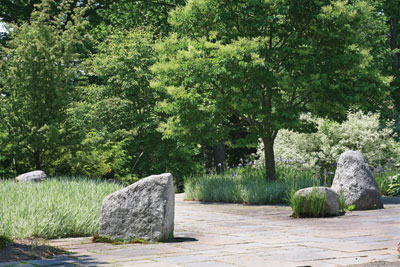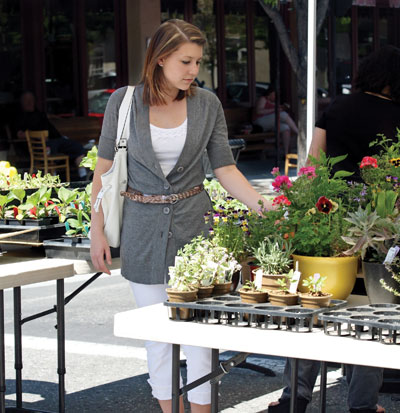
Plant esthetics generally drive consumer interest, but increasingly
customers are gaining knowledge and interest in the various non-visual
uses and benefits of plants.
Plant esthetics generally drive consumer interest, but increasingly customers are gaining knowledge and interest in the various non-visual uses and benefits of plants. Driven by environmental concerns, customers may, for example, be interested in plants that serve as natural mosquito repellents or which might deter rodents. Others, who perhaps have seasonal homes or travel frequently, or who reside in areas with water bans throughout the summer, might be interested in drought-tolerant plants. Which plants have holistic benefits? Which attract birds and butterflies? Which plants serve to keep down weeds or provide barriers to neighbouring yards?
 |
|
| After last summer’s blasting heat and infernal dry spells decimated gardens in many parts of Canada, consumers will be looking for drought-resistant plants to replace the carnage. How will you convey your expertise on this front in a way that translates to sales? Advertisement
|
The benefits and appeal of plants beyond merely their esthetic value is a great, though underused means of a garden centre driving sales. So how best to communicate these features, and interest potential clients in adding them to their landscapes?
Newsletters
The most obvious and traditional way of conveying information is via signage, but this method isn’t congruent to communicating in depth information. Nor is training or adding staff always the best route, as the decision on which plants to add often comes at the busiest garden centre season.
“At Griffin’s Greenhouses we have good signage to communicate the various uses and benefits of plants to customers, but we’ve found that in our modern-day ‘instant gratification society’ not everyone wants to stand quietly and read sign after sign, bullet point after bullet point. And realistically, in the busy times, you cannot have staff members solely responsible to chat up the benefits of lavender, for example, for the purposes of relaxation, to customers one-by-one,” explains Victoria Whitney, manager of Griffin’s Greenhouses in Peterborough, Ont.
“With that in mind, we use our newsletter (monthly/bi-monthly, depending on the season) to communicate info about specific benefits of plants. That way our customers can read it at their leisure. We send our newsletter electronically, and also print up to 2,000 copies to distribute at the cash desk. We also post facts about plants (compatibility, recipes for planting combos, care tips) every couple of days on our Facebook page and encourage discussions about what was posted to get the excitement to buy flowing.”
QR codes
QR Codes are the newest trend in ‘speaking’ with customers, and allow you to post a lot of information in a small space.
If you’re not familiar with QR codes, they’re similar to barcodes. The key difference between the two is the amount of data they can hold and share. Barcodes are linear one-dimensional codes and can hold up to 20 numerical digits, whereas QR codes are two-dimensional matrix barcodes that can hold thousands of alphanumeric characters of information.
Their ability to hold more information and their ease of use make them practical for small businesses seeking to ‘talk’ with customers. When you scan or read a QR code with your iPhone, Android or other camera-enabled smartphone, you can link to digital content on the web, activate e-mail, and connect the mobile device to a web browser. Given that over 40 per cent of Canadians own such phones, the potential reach is vast.
The ability of QR codes to connect people with each other and to multimedia digital content is very useful for businesses and consumers alike. It provides a cost effective means of promoting ‘problem solver’ plants and communicating their features and benefits. Simply scan the code with your device and information is immediately at hand. As a result of their utility, QR codes are everywhere and small businesses are worried about missing out if they don’t pixel up.
Still, it’s important to keep things in perspective. A report from Comscore – one of the premier Internet ratings firms – says that only 14 million Americans (or about five per cent of the population) looked up QR codes last year, and they skewed wealthy and male. The ability to scan a code, in other words, doesn’t translate into a compelling reason to scan a code. When you consider this, and the fact that those who are most likely to scan a QR code aren’t generally a garden centre’s primary target demographic, it becomes apparent it’s best to use this new technology strategically.
Displays
Creative, well-considered strategic merchandising is still one of the most effective ways of attracting a customer’s attention. As a result, don’t overlook them as a means of promoting problem-solver plants.
 |
|
| Whether it’s edibles, pest-deterrent plants, or weed inhibiting ground cover, don’t assume clients know the package you’re trying to sell. Use signage, workshops, thematic displays, and even QR codes to tie it together for them.
|
“Merchandising is all dependent upon size of retail area. If you have a large sales floor, several displays with cross-merchandising is a great way to show how much expertise your company has, and thus drive sales. If your retail area is small, a single display that rotates once per week or so can achieve the same effect,” explains Patricia Ingram, of Cobblestone Garden Centre in Calgary.
“An example of a comprehensive display in the greenhouse could be a Songbird Centre. This would be an area with the theme of songbirds and could feature a small birdhouse and feeder display (make sure you pick styles that can get wet and are easy to dust), along with plants that feature tubular blooms, such as petunias, hibiscus, and fuchsia.”
Yet don’t assume shoppers will figure things out on their own. Signage is important to creating an effective display, and to getting customers comfortable enough with their own knowledge to make the leap.
“Signage needs to show the theme (in this case, “Invite Songbirds to Your Yard”), plus have some relevant facts,” continues Ingram. “For example, you might point out that ‘Gorgeous species in our area include Rufous Hummingbird, American Goldfinch, and Chipping Sparrow,’ ‘Songbirds are migratory and are known to return to the same yard year after year,’ and ‘We also feature a full selection of feeders and houses in store!’ Smaller signage should have plant varieties and pricing.”
In other words, make it easy for the client to make the leap and try something new.
Workshops
Interactive promotions of any kind are valuable for getting customers enthused about new ideas or products. They are also perhaps the most cost-effective way of driving sales in particular items, as a little knowledge goes a long way in getting clients to invest.
“We at Griffin’s Greenhouses host workshops that allow us to share information on any subject with customers. Many of our workshops are hands-on and information can be shared during the experience to create more value for the participant,” explains Whitney. “For example, this year we will be hosting a workshop called ‘how to maintain a four-season perfect porch pot’ with tips on what plants to plant for specific environments, in combos that really work well together, how to maintain in each of the four seasons, and pitfalls people often fall into with these urn inserts or porch containers. We have also done workshops on ‘harvesting and using herbs’, ‘shady, dry cottage gardens’, ‘perennials and annuals: friends forever’, and other topics.”
 |
|
| You know which plants attract birds or butterflies. Many of your clients would like to know too. Why not share that information in a meaningful, easy way to give shoppers one more reason to make the buy?
|
Each informational workshop should come with a handout sheet and a shopping list of plant material, soil amendments, and other suggested items for the participants to be successful. Extra handouts should be kept handy for staff to share with other customers.
Whitney notices that sales drive up noticeably in the weeks after workshops, clearly demonstrating the reward for the time put into hosting these events.
Whether it is through signage, displays, workshops or newsletters, taking the time to educate customers about the benefits of plants beyond their obvious physical characteristics is well worth the effort. This not only differentiates the independent garden centre from some of the big box versions, it opens new gardening horizons for clients to explore. It also increases the value of gardens beyond the esthetic, into the realm of the practical.
Indeed, this knowledge transfer should be the goal of every garden centre owner, manager, and staff member, because it’s what transforms a casual customer into a passionate one.
| Hey good lookin’, what you got cookin’? Consumers may want to know more about plants that can be useful around the yard and deck instead of beautiful, but what about plants that can do both? What if you could have your pretty flower, and eat it too? That’s the point behind a breed of roses from Tesselaar Plants, a supplier that suggests we look at the rose through new coloured glasses. “If you’ve only thought of roses as a table centre-piece or garden fixture – think again,” says Anthony Tesselaar, cofounder and president of Tesselaar Plants, developer of the Flower Carpet rose. If grown in an environmentally responsible fashion, they can make a solid complement to many meals, he explains. Tesselaar is not alone. The International Herb Association selected the rose as the 2012 Herb of the Year and the supplier says nurseries and garden centres across the country are expecting edible plants to play big this year. But take heed before you start serving up petals, experts warn. Kitty Morse, author of Edible Flowers, A Kitchen Companion, cautioned, “make sure the flowers you choose have been grown naturally, without the use of pesticides.” Morse, whose book will be re-released this year as an eBook, said for that reason, most fresh-cut flowers from florist shops and nurseries are unacceptable. One of the best ways is to harvest from your backyard or from another reliable organic source. Unfortunately, many fragrant heirloom roses are susceptible to pests such as spider mites, borers and Japanese beetles or funguses and viruses, leading many gardeners to turn to pesticide treatments. This is where low-care environmentally friendly roses, such as Tesselaar Plant’s Flower Carpet Roses, come in. They have been bred to be drought and disease resistant, and have a long-flowering period. Incorporating flowers from the garden into creative dishes should be as easy as walking into your backyard with a pair of shears,” said Diane Hughes Schaffner, an Illinois-based organic gardener and local food advocate, who is no stranger to tasting the flowers in her garden. “I’m all about the edible landscape,” she said. And while she hasn’t tasted her roses yet, it’s probably just a matter of time. “There’s not a dish of mine that goes to a summer party without the garnish of nasturtium blossoms.” Read more about Flower Carpet Roses at www.canadiangardencentre.ca. |
Print this page